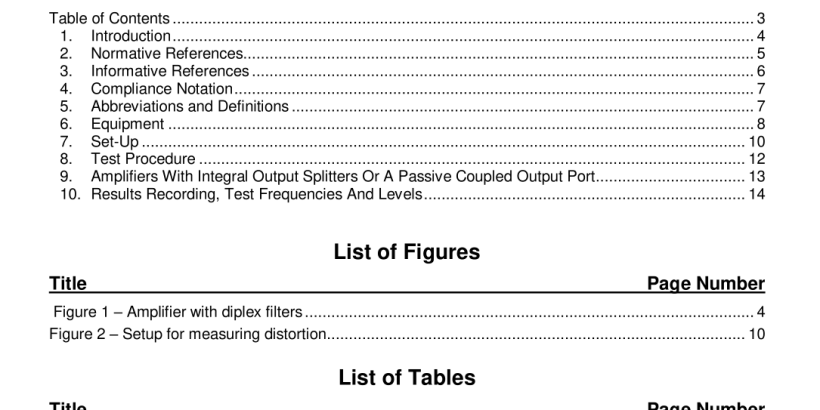ANSI SCTE 126-2019 pdf download.Test Method for Distortion of 2-way Amplifiers Caused by Insufficient Isolation of Built in Diplex Filter
In a two way Cable Telecommunication Systems, amplifiers are commonly used to amplify downstream signals. These amplifiers are designed as shown in Figure 1. They consist of two diplex filters with amplifier inserted in the high pass path, also known as the forward or downstream path. The low pass path (return or upstream) in most cases needs no amplification, and is used for upstream communication of modems, telephony, etc. In some cases, a return amplifier is used. Upstream communication uses high- level signals, reaching in some cases up to 55 dBmV. Serious problems with second harmonics can arise due to insufficient diplex filter isolation of amplifiers, as it can be seen in Figure 1. Diplex filter isolation is usually the worst in the last 2 MHz. of the high frequency end of the upstream pass band. If high-level signals are applied at these frequencies, second harmonics can be created causing distortion on the corresponding channel. If the amplifier also has a built in return amplifier, distortion problems can be even more serious, since the harmonic levels are higher by the gain of the return amplifier. Measurement of this distortion is most practical by measuring the 2nd harmonic of a CW carrier, since signal generators and spectrum analyzers are commonly used in many other test procedures.
4. Compliance Notation
This word or the adjective“required’ means that the item is an absolute requirement of this document. This phrase means that the item is an absolute prohibition of this document. This word means the value specified shall never be used. This word or the adjective“recommended’ means that there may exist valid reasons in particular circumstances to ignore this item, but the full implications should be understood and the case carefully weighted before choosing a different course. This phrase means that there may exist valid reasons in particular circumstances when the listed behavior is acceptable or even useful, but the full implications should be understood and the case carefully weighed before implementing any behavior described with this label. . This word or the adjective“optional means that this item is truly optional. One vendor may choose to include the item because a particular marketplace requires it or because it enhances the product, for example; another vendor may omit the same item. Use is permissible for legacy purposes only. Deprecated features may be removed from future versions of this document. Implementations should avoid use of deprecated features.
9. Amplifiers With Integral Output Splitters Or A Passive Coupled Output Port
In addition to creating second harmonic distortion as described in section 1.0, multiple output amplifiers that utilize splitters at the output of the final stage of amplification or a coupled passive port that utilizes a coupler or splitter at the input to the amplifier create second harmonic distortion also due to nonlinearity of the ferrites used in the coupler or splitter. This nonlinearity is caused either by magnetizing of the ferrites, or poor ability of the ferrites to handle high-level signals. The second harmonic distortion determined in this test is either caused by insufficient isolation of the diplex filter, or nonlinearity of ferrites, or combination of both. For these reasons, in order to get the worst-case test results; the multiple output amplifiers must be exposed to magnetization currents of the specified surge for the product, as described in American National Standard procedure ANSI/SCTE 81 2012. There is no need to surge the amplifier with the full surge test as described in section 6.4 of ANSI/SCTE 81 2012, since this is not a surge withstand test, but a ferrite magnetization stimulation. Each output port must be exposed to 4 alternate ± 1kV 0.5 µs-100 kHz surges as defined in the standard mentioned above. The test procedure is then exactly the same as described in section 8F.0, Test Procedure. Unused ports of the multiple output amplifier must be properly terminated during testing.ANSI SCTE 126-2019 pdf download
